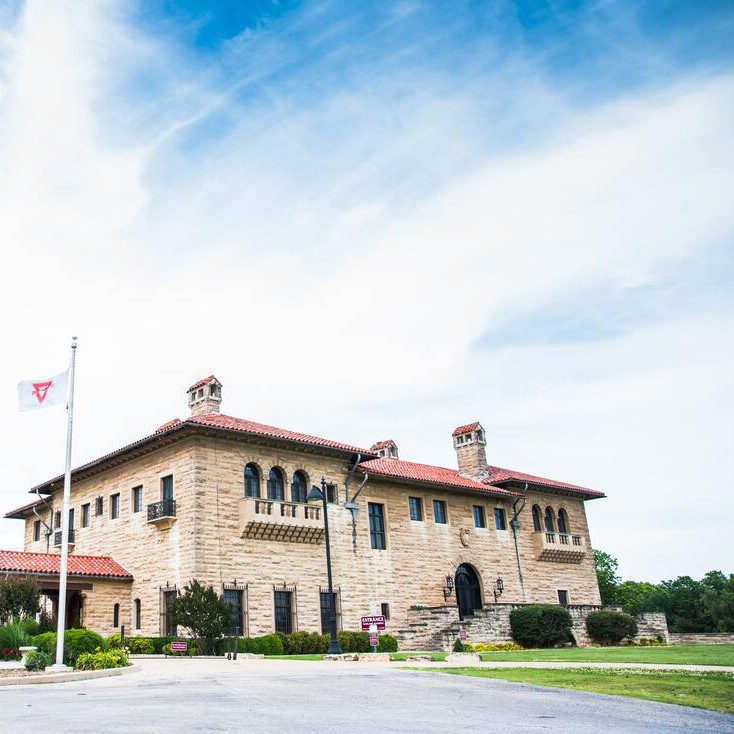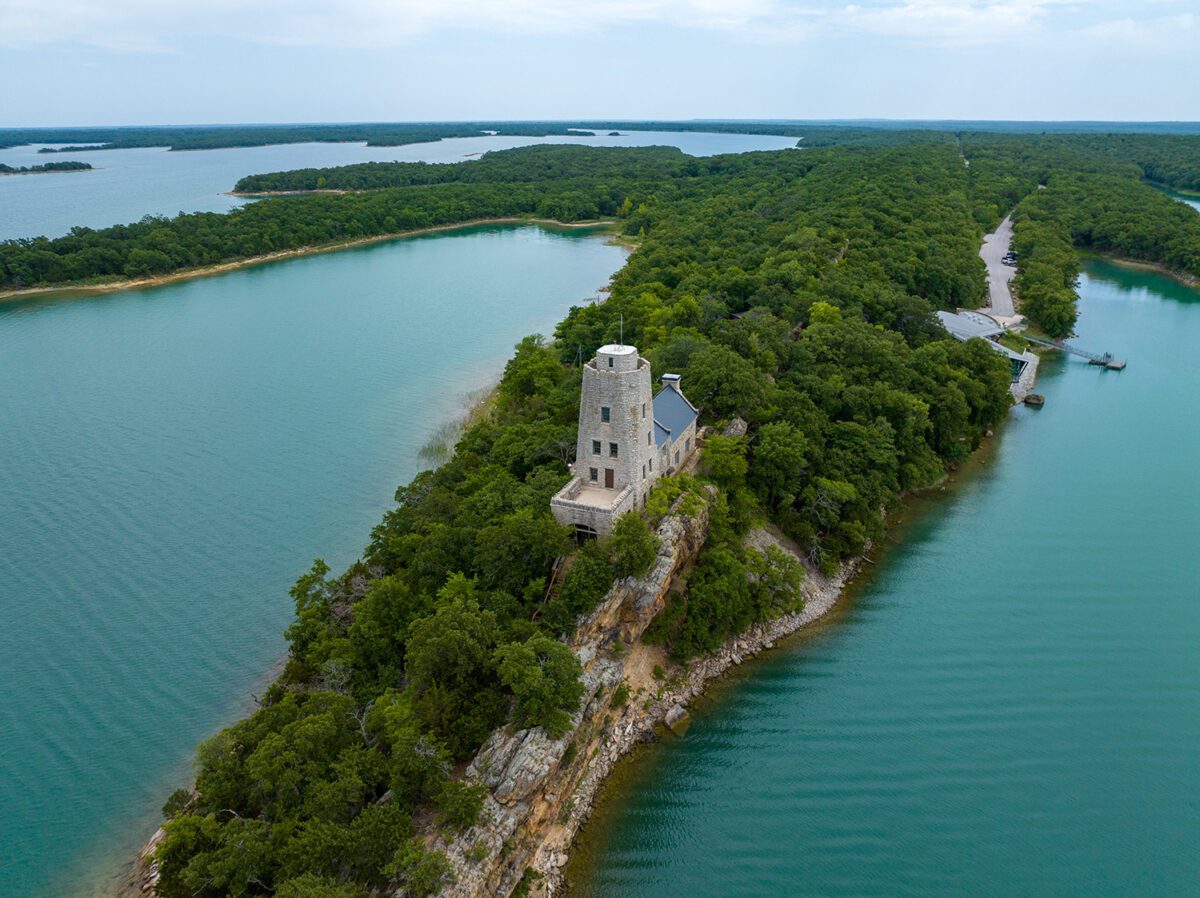Tulsa
Bartlesville
Bartlesville may be known as a historic oil town, but this city has been expanding steadily and revitalizing its downtown, too.
“People that come here are always so pleasantly surprised with how clean and cute our downtown is,” says Maria Swindell Gus, executive director at Visit Bartlesville.
In 2020, the city opened the Tower at Unity Square, a voter-approved green space, which acts as a gathering place for community events. Residents can enjoy fitness classes, bingo and live music year-round.
“It really has become the heart of this community,” says Swindell Gus.
Within walking distance of the square are several attractions, including the Bartlesville Public Library, the Phillips 66 Museum, the Frank Phillips Home and Theater Bartlesville.
“Twenty years ago, downtown was mostly empty storefronts,” says Swindell Gus. “Now it’s really a thriving, bustling area.”
Residents can also take part in outdoor recreational activities. The city’s expansive system comprises 17 parks featuring amenities like swimming pools, walking trails and dog parks. At the Woolaroc Museum and Wildlife Preserve, visitors can spot more than 30 species of wildlife roaming 3,700 acres.
Retirees may find Bartlesville particularly attractive for its size, nearby metropolitan cities and affordable housing. According to Zillow, the average home value is $174,117.
Swindle Gus notes that the community is very welcoming, too. For instance, the Osher Lifelong Learning Institute in Bartlesville offers courses to adults of all ages. Retirees can acquire new skills and learn about topics ranging from history to cuisine.
“My mom is 89, and she’s super active,” Swindle Gus shares. “She goes to classes [at OLLI] all the time. She’s taken a film class and a wine-tasting class. There are a lot of opportunities to meet other people and explore a diverse range of interests.”
Muskogee
Situated 50 miles west of the Oklahoma-Arkansas state line, Muskogee prides itself on a rich, diverse history. The Three Forks Area, which encompasses Muskogee county, was a hub of settlement for Native American tribes and European settlers. In 1905, several Indigenous tribes gathered to create a constitution that would recognize Indian Territory as the State of Sequoyah. At this historic convention, Muskogee was elected as the proposed state capitol.
As such, retirees with a special interest in history will appreciate Muskogee’s attractions. From the Three Rivers Museum to the Five Civilized Tribes Museum, there’s an abundance of institutions and historic sites that aim to preserve the city’s unique heritage.
Muskogee has established several parks in honor of its military history, too. At the War Memorial Park, residents and guests can tour the U.S.S. Batfish, a War World II submarine manned by a highly decorated crew.
Deemed the “crowned jewel” of the city’s parks system, Honor Heights Park was established in memory of World War I soldiers. The park spans 132 acres, featuring picnic areas, fishing docks, tennis courts and the Papilion Butterfly House. Honor Heights Park is also the hub for many of Muskogee’s most beloved festivals. In April, Honor Heights Park holds the Azalea Festival in celebration of the blooming of 30,000 azalea bushes. During the winter season, the park transforms into a twinkling wonderland for the Garden of Lights.
To promote health and wellness among the senior community, the city holds the Muskogee Senior Games every year. The event draws people over the age of 50 from across the region, giving them the opportunity to compete in athletic activities, including golf, bowling, swimming, pickleball and more.

Okmulgee
Flowing springs and scenic views are the mainstays of Okmulgee. Although the city is less than an hour drive from Tulsa, residents enjoy a slower pace of life. As of 2023, Okmulgee had a population of 11,367 with 16% of its residents over the age of 65.
Retirees can unplug from the hustle and bustle of major cities and connect with the great outdoors. Established in 1927, the Okmulgee and Dripping Springs Lake and Recreation Area features two parks with lakes, camping sites and hiking trails.
Another outdoor destination is the Deep Fork National Wildlife Refuge, which was established to protect one of the only bottomland hardwood forests in Oklahoma. Stretching 34 miles along the Deep Fork River, the refuge is home to more than 149 species of birds and other indigenous wildlife. The park also has several hiking trails and fishing spots.
Beyond outdoor recreation, Okmulgee has preserved a bevy of historic spots. Over 140 buildings in the Okmulgee Downtown Historic District have made their way onto the National Register of Historic Places. The downtown area hearkens back to the city’s ties to the Creek Nation Capitol and a thriving African American business district.
The Creek Nation Council House also holds historical significance. Founded in 1868 by the Muscogee Nation, Okmulgee remains the home of the tribe’s legislative body, executive branch and tribal court system.
For entertainment, retirees can try their luck at One Fire Casino, which boasts a selection of more than 350 electronic games. During the holidays, residents can gather their loved ones for the Annual Festival of Lights Parade, which includes festive floats, hot cocoa and elaborate light displays.
Ponca City
With a storied past tied to the oil boom and the 60-mile wide Cherokee Outlet, Ponca City offers residents a variety of cultural and historic attractions. The city has built a reputation as “the jewel on the prairie” for its sprawling natural landscapes and enduring pioneer spirit.
Ponca City’s small-town charm may appeal to retirees who are looking for a tight-knit community. Not too small and not too big, the population in Ponca City sits at 24,306.
Ponca City has been recognized as a City of Character, a nationwide program led by the International Association of Character Cities. The program encourages citizens to embody positive traits in their daily lives, such as respect and resourcefulness.
Locally owned operations, such as the Blubaugh Angus Ranch and Big V Ranch, preserve Ponca City’s roots in agriculture. At Silvertop Farm and Vineyards, visitors can observe historical reenactments, tour the grounds, and take wine-tasting lessons.
Another draw is the E.W. Marland Mansion and Estate. Founded in 1928 by an oil baron who once controlled a tenth of the world’s oil reserves, the mansion has become a historic and architectural attraction. The Marland family originally built the Italianate residence for $5.5 million. In the 1940s, the mansion was operated by the Felician Sisters as a nunnery before it was acquired by the City of Ponca City.
Residents can also learn more about women’s impact on Oklahoma history at the Pioneer Woman Museum. Built in 1957, the museum features interactive exhibits and educational programming. Visitors can also take part in hands-on activities, such as quilting, knitting and spinning.
Other popular attractions in the area include Standing Bear Park, Conoco Museum and Poncan Theater.

Oklahoma City
Ardmore
Located in south Oklahoma, Ardmore offers small town charm and big city amenities.
“Ardmore has been a center of commerce,” says Bill Murphy, president and CEO of the Ardmore Chamber of Commerce. “It’s history in the cotton and oil and gas industries created generational wealth that afforded people to bring resources and amenities to the community.”
The combination of cultural, outdoor and community-based activities has made the growing city a hotspot for retirees. Approximately 23% of residents are over the age of 60.
Oklahoma’s first and most expansive park, Lake Murray State Park, is located in Ardmore. The park spans 12,500 acres of wooded land, offering a robust trail system and sport facilities for adults of all ages to enjoy. Plans to develop the parks and recreation even more are underway.

“The work that the City of Ardmore is doing for its parks and recreation is commendable,” says Murphy. “They’re not only investing in our parks, but they’re working on the walk-ability of the community.”
One area ideal for strolling is the Depot District, which has been revitalized into a flourishing commercial zone. From salons to clothing boutiques, it provides plenty of restaurants, entertainment and shopping. For retirees who have a passion for the arts, the Goddard Center for the Visual and Performing Arts brings rotating exhibits and live performances to the local scene. Situated on the same grounds is the Ardmore Little Theater, which recreates classics like Midsummer Night’s Dream and The Wizard of Oz for season ticket holders.
Residents also benefit from easy access to healthcare. Constructed in 1898, the Mercy Hospital Ardmore is a 190-bed facility that offers a network of 2,300 primary and specialty medical providers. The hospital has been recognized as a top 100 rural and community hospital by the Chartis Center for Rural Health.
Ada
Founded in 1891, Ada is a progressive community situated in southern Oklahoma. The city acts as the headquarters for the Chickasaw Nation, which has long promoted the area as a destination for tourism and leisure.
Ada’s Main Street highlights the city’s vibrant past through historical landmarks and a lively arts district. Residents can find plenty of entertainment at the 100-year-old McSwain Theatre, which was built in the 1920s as a venue for vaudeville performances and silent movies. Ada Main Street is also used as a gathering place for pop-up markets and food trucks. In the winter, residents can gather for seasonal festivals that include craft shows, carriage rides, parades and pictures with Santa.
Year round, retirees can find several things to do in town. Soak in picturesque views and sip on hand-crafted wines at Waddell Vineyards, a family owned and operated seven-acre vineyard. Throughout the year, the vineyard hosts fun events, like “Sip and Swirl” painting classes.
Make a splash at one of Ada’s aquatic centers or grab a drink at Ada’s Gaming Center. In the summer and winter seasons, the Ada Shakespeare Company puts on outdoor performances of Romeo & Juliet, Julius Caesar, and other plays at Wintersmith Park.
Deemed one of the best racing facilities in the state, the Oklahoma Sports Complex provides spectators with an evening full of thrills and excitement. Races are held on select dates starting at 7:30 p.m.
Seasonally, residents can gather fresh produce, including watermelon, jalapenos and blackberries at the Peach Tree Farms Orchard and Fruit Stand. The farm also sells locally crafted goods, ice cream and pies.
For its beautification and environmental efforts, Ada was named a Tree City USA by the Arbor Day Foundation in 2022.
Lawton
Chock-full of history and cultural destinations, Lawton is an excellent place to retire. One of the biggest tourist attractions in the area is the Museum of the Great Plains, which showcases archaeological artifacts from the Paleo-Indian cultures. The museum also offers self-directed activities and temporary exhibits for visitors to explore. Retirees can support the entity by becoming a “Friend of the Museum.” These volunteer opportunities range from assisting with the archive and collections to helping with fundraising efforts and special events.
Another cultural and historical landmark is the Fort Sill National Historic Landmark and Museum, which is located three miles north of the city. The fort was originally constructed between 1869–1870, serving as a cavalry post for controlling the Indigenous tribes of the southern plains.
The fort is made up of 26 historic buildings, and the grounds contain the burial sites of Chiricahua Apache leader, Geronimo and Comanche leader, Quanah Parker. The fort currently serves as the home of the United States Army Field Artillery School.
About 22 miles northwest of Lawton is the Wichita Mountains Wildlife Refuge, which spans 59,000 acres. Attractions in the refuge include the Holy City of the Wichitas, Parallel Forest, Mount Scott and Quanah Parker Lake.
Seniors that are looking for opportunities to connect with their community can join the AmeriCorps Seniors in Lawton. This volunteer-based organization provides a plethora of community-focused activities, from clean-up programs to community drives.
The Center for Creative Living also serves people over the age of 55 by providing a dedicated space for seniors to meet their social, physical and intellectual needs. Group activities, including quilting, aerobics and painting classes, help members build a social network thereby enhancing their quality of life.
Chickasha
Originating from a railroad stop in the late 1890s, Chickasha has steadily grown into a small city of its own. Although it has accumulated a population of nearly 17,000 people, the city preserves its historic charm.
In the last decade, Chickasha has focused on revitalizing its depot, which sat empty for several years. It has since become a destination for community events.
“When you see our historic Santa Fe Depot, you literally feel like you’re walking back in time,” says Jim Cowan, president of the Chickasha Chamber of Commerce and executive director of the Chickasha Economic Development Council.
Chickasha’s main claim to fame is its Festival of Lights. The annual light show features 3.5 million twinkling lights and draws over 250,000 people from across the region annually.
“People have been coming here and building their holiday traditions around the festival,” says Cowan. “We believe we’re the kind of town that you’d see in a Hallmark Christmas movie.”
No matter the time of the year, retirees can enrich their lives with nearby activities. Home of the longest-running golf tournament in Oklahoma, the Chickasha Golf and Country Club is a popular spot for leisure and social activities. The Chief Drive-In is a favorite among locals, too; the drive-in presents many releases and old classics for families to enjoy.
With eight distinct residential areas in development, retired folks can find affordable housing options, from apartments to homes in gated communities. The average home value in Chickasha sits at $135,610, which has increased by 3% since last year.
Posed for continued growth, the community continues to prioritize making the city attractive for residents and tourists alike.
“This place will always be very special to me,” says Cowan. “Here I am, at age 61. I have an opportunity similar to my dad in terms of [his legacy] and making the town I grew up in better prepared for the future.”

























